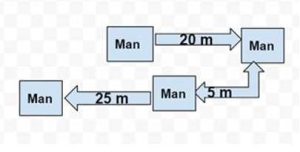Do you all know that speed and velocity are not the same things? Speed is a scalar quantity, while velocity is a vector quantity. Speed tells us how fast an object is moving, while velocity measures the rate at which an object changes its position.
Similar to how distance and displacement are distinct, speed and velocity have different meanings despite their similarities. Before delving into what each of these terms denotes, their similarities, and their differences, let us first understand some of the basic terms involved in explaining the concept of average speed and average velocity.
So, let’s learn the fundamental difference between average speed and average velocity.
Fundamental Terms Explained
- Scalar quantity- Scalar is a physical quantity that only has magnitude. There is no specific direction described for a scalar quantity, for instance, mass, electric charge, distance etc.
- Vector quantity- A vector quantity is defined by both magnitude and direction. The value of a vector quantity changes if either of the two parameters, i.e., magnitude and direction, is changed. A few examples of vector quantities are force, momentum, displacement, etc.
- Distance- The amount of ground covered by an object during its motion is measured by distance. It is a scalar quantity.
- Displacement- This denotes how far the object was from its original position when it started moving. It is the overall change in the object’s position and is a vector quantity.
- Speed- The distance an object travels in one unit of time is called its speed. It is a scalar quantity without any direction. Speed measures how fast an object is moving. The faster an object is, the higher its speed. An object under slow motion is said to have a low speed. An unmoving object has zero speed.
- Velocity- The rate of change of position of an object during its motion is denoted by its velocity. Velocity has a direction along with magnitude, so it is a vector quantity. So, if an object is moving one step forward and then back to the same place rapidly, the object might seem to be in a frenzy of motion, but it possesses zero velocity. This is because the object constantly comes back to its original position resulting in no net change in position.
To maximise its velocity, an object must take every step to move further from its starting position. It is not enough to state the velocity of an object as 35 miles/hour since velocity also needs a direction associated with it. So the correct way of stating the velocity of an object would be 35 miles/hour, West. Velocity, in simple terms, is the speed with a direction.
- Average Speed- When you divide the total distance an object has travelled by the total time taken to travel it, you get the object’s average speed. Average speed denotes the average rate at which the object would cover a certain distance. So if we say an object has an average speed of 20 km/hr, it means the object would, on average, cover 20 kilometres in one hour. Average speed denotes a rate and is measured by dividing distance by time.
- Average speed (s) = distance (d)/time(t) i.e. s = d/t.
○ Speed’s S.I unit is meters/second.
- Average velocity- Average velocity is different from velocity. Velocity measures the rate of change of distance with respect to time, whereas average velocity gives you the average total displacement of the object over the total travel time. You obtain average velocity by calculating initial and final velocities and finding their average. The change in position here refers to overall displacement and not the total distance covered. Average velocity denotes the velocity of an object when it is moving at the same speed and in the same direction over time. For an object that changes its direction through its motion, we take the initial direction of movement as the reference point. The formula for calculating average velocity is given below:
- Average velocity (Vav,d) = (displacement Δd)/(duration Δt)
Similarities between Average Speed and Average Velocity
- Both average speed and velocity are similar in that both measure the length travelled by an object over time.
- The SI unit for average speed and velocity are the same (meter per second).
- The formula used to calculate average speed and velocity are practically the same. Both divide distance by time.
Differences Between Average Speed and Average Velocity
Average speed and velocity might have different magnitudes for an object that is changing direction over time. In general, for an object that changes its direction during its course of motion, the average speed is greater than the average velocity. Some of the main differences between average speed and average velocity are:
- Average speed is the total distance travelled per unit of time, while average velocity is the total displacement of an object per unit of time.
- The average speed is a scalar, and the direction of an object does not affect it. Average velocity is a vector and is dependent on the change in the direction of the moving object.
Understanding The Concept through Solved Examples
Let us look into some real-life situations to understand the difference between average speed and velocity:
- A train covers a distance of 100 meters in 10 seconds in the East direction. What is the average speed and average velocity of the train?
Solution – Average speed = total distance/time taken = 100/10 = 10 meters/sec.
Average velocity = total displacement/time taken = 100/10 due East = 10 meters/sec, East.
Note: In this case, the magnitude of both average speed and velocity are the same since the train is not changing directions.
- A man moves 20 meters towards his right to get his laptop. He then moves 5 meters to his left to get a cup of coffee. Then he moves 25 meters left towards his desk to sit and work. He takes 300 seconds for the entire motion. What are the man’s average speed and average velocity?
Solution- Let us first draw the entire movement of the man with arrows:

Total displacement = 20 – 5 – 25 = -10 meters
Total distance = 20 + 5 + 25 = 50 meters
Total time = 300 seconds
Putting all the knowns in th formula we learnt above we get:
Average speed = total distance/total time = 50/300 = = 0.17 meters/sec
Average velocity = total displacement/total time = -10/300 = -0.003 meters/sec
Conclusion
Understanding scientific terms will help do the correct calculations for better results. Speed and velocity are two critical factors a student should understand well. Use the concepts in the right questions to get the desired results.


